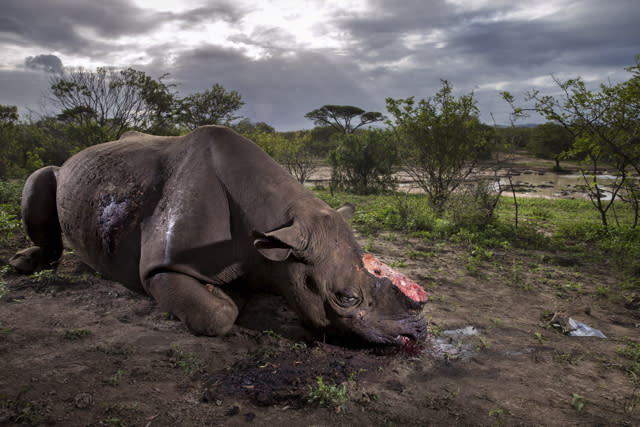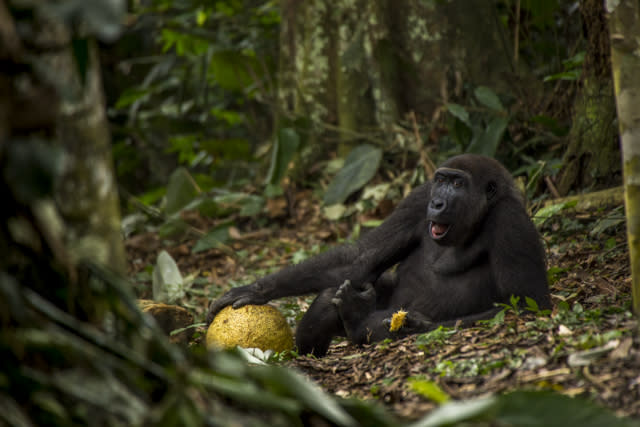Image of rhino with horn hacked off wins Wildlife Photographer of the Year award

Brent Stirton
A shocking image of a black rhino with its horn hacked off has won the Wildlife Photographer of the Year award.
Brent Stirton won the top accolade for his tragic and poignant image of a rhino that had been killed by poachers, called 'Memorial to a Species'.
See also: Vets rescue wild rhino with tyre stuck on snout
See also: White rhino joins Tinder to preserve future of species
The image was taken at the Hluhluwe-Imfolozi Game Park game reserve in South Africa.
The winning images are selected by the Natural History Museum's international jury.
Its website explains: "Wildlife Photographer of the Year champions ethical photography. Images are chosen for their artistic composition, technical innovation and truthful interpretation of the natural world."
More than 1,000 rhinos are killed every year for their horns. The New Scientist reports that the illegal trade is driven by the false belief that rhino horn can cure ailments from kidney stones to cancer, and criminals sell it to make profits greater than for gold or cocaine.
The site explains that photojournalist Brent has spent five years following and documenting this atrocity. In a series of images, he also shot pictures of the volunteers who rescue the babies of poached rhinos.
Talking about the image, Lewis Blackwell, Chair of the jury, said: "Taken as part of an undercover investigation into the illegal trade in rhino horn, Brent's winning image tells the evocative story of one of the trade's latest victims – a black rhino bull from South Africa's Hluhluwe Imfolozi Park. The poachers responsible are thought to have come from a local community, working to order. After entering the reserve illegally, they ambushed the rhino at a waterhole, shooting it dead before fleeing from its mutilated body.
"Brent's poignant image is symbolic of the devastating impact of the demand for rhino horn. Black rhinos were once the most numerous of the rhino species.
"However, it was estimated in 2015 that only 5,000 remained in the wild – a number that conservationists believe to have fallen since due to increased poaching. These critically endangered animals will become extinct unless effective and compelling action is taken.
"When an image shocks and assaults us, there needs to be good reason. With this one, there is. The stark simplicity forces us to witness the brutal, tragic, stupid waste of a poacher's work.
"If we feel disgust it is at our own species, while we pity the black bull rhino for its ghastly death, killed by two shots just so that its horn could be hacked off to supply illegal trade in a questionable "medicine". There is a horrible intimacy to the photograph: it draws us in and invites us to explore our response and responsibility."
Natural History Museum Director Sir Michael Dixon said: "Brent's image highlights the urgent need for humanity to protect our planet and the species we share it with. The black rhino offers a sombre and challenging counterpart to the story of 'Hope' our blue whale.
"Like the critically endangered black rhinoceros, blue whales were once hunted to the brink of extinction, but humanity acted on a global scale to protect them. This shocking picture of an animal butchered for its horns is a call to action for us all."
Liz Bonnin, Science and Wildlife Presenter , said: "This year's winning image conveys a powerful and disturbing message from a master storyteller, shining a light not only on a species being pushed to the brink of extinction, but also on the issues of human morality and compassion for the animals we share this planet with."

Other winners include Daniel Nelson, from the Netherlands, who picked up Young Wildlife Photographer of the Year for his image of a gorilla lying on a Rwandan forest floor eating breadfruit.
The exhibition opens for public viewing at the Natural History Museum this Friday 20 October and closes on Monday 28 May.
See more the full list of winners in the slideshow below.




